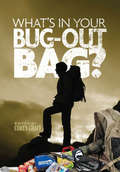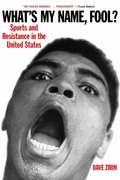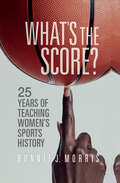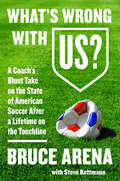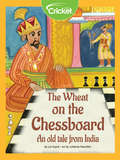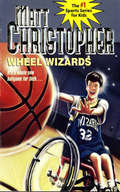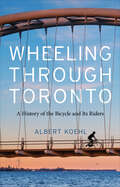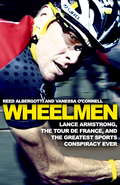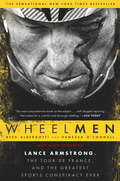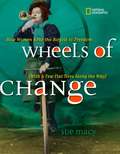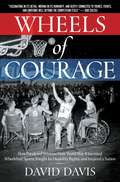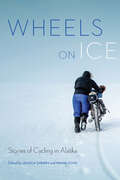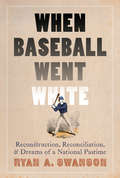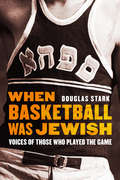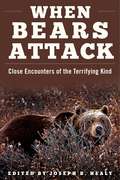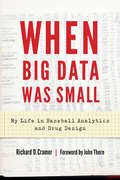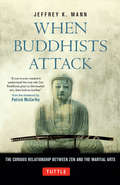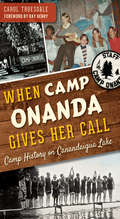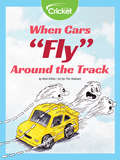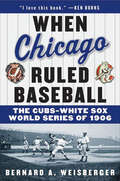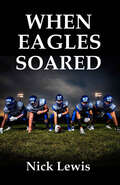- Table View
- List View
What’s in Your Bug Out Bag?: Survival kits and bug out bags of everyday people. (Survival & Preparedness)
by Corey GraffIn What's In Your Bug Out Bag?, you'll hear from 15 everyday people as they describe their actual bug out bag list - the ultimate 72-hour go-kit guide from and for real people. Get survival kit ideas and find out what first aid, shelter, navigation, food, water and personal protection items people are counting on to get to safety. Each bug out bag checklist is described and analyzed by our expert staff plus in the words of the people who assembled these bug out bags. If you're wondering how to make a survival kit or how to make a bug out bag you've come to the right place.In What's In Your Bug Out Bag? You'll Learn:Popular gear for bugging out and preppingHow to choose the best backpacks for bug out bagsHow to organize and prioritize gear for your bug out bag
What's in Your Pocket?: Collecting Nature's Treasures
by Heather L. MontgomeryCharles Darwin, George Washington Carver, and Jane Goodall were once curious kids with pockets full of treasures!When you find something strange and wonderful, do you put it in your pocket? Meet nine scientists who, as kids, explored the great outdoors and collected "treasures": seedpods, fossils, worms, and more. Observing, sorting, and classifying their finds taught these kids scientific skills--and sometimes led to groundbreaking discoveries. Author Heather Montgomery has all the science flair of a new Bill Nye. Book includes the Heather's tips for responsible collecting.
What's My Name, Fool?
by Dave Zirin"Zirin is America's best sportswriter."--Lee Ballinger, Rock and Rap Confidential"Zirin is one of the brightest, most audacious voices I can remember on the sportswriting scene, and my memory goes back to the 1920s."--Lester Rodney, N.Y. Daily Worker sports editor, 1936-1958"Zirin has an amazing talent for covering the sports and politics beat. Ranging like a great shortstop, he scoops up everything! He profiles the courageous and inspiring athletes who are standing up for peace and civil liberties in this repressive age. A must read!"--Matthew Rothschild, The Progressive"This is cutting-edge analysis delivered with wit and compassion."--Mike Marqusee, author, Redemption Song: Muhammad Ali and the Spirit of the SixtiesHere Edgeofsports.com sportswriter Dave Zirin shows how sports express the worst, as well as the most creative and exciting, features of American society.Zirin explores how Janet Jackson's Super Bowl flash-time show exposed more than a breast, why the labor movement has everything to learn from sports unions and why a new generation of athletes is no longer content to "play one game at a time" and is starting to get political.What's My Name, Fool! draws on original interviews with former heavyweight champ George Foreman, Olympian and black power saluter John Carlos, NBA basketball player and anti-death penalty activist Etan Thomas, antiwar women's college hoopster Toni Smith, Olympic Project for Human Rights leader Lee Evans and many others.Popular sportswriter and commentator Dave Zirin is editor of The Prince George's Post (Maryland) and writes the weekly column "Edge of Sports" (edgeofsports.com). He is a senior writer at basketball.com. Zirin's writing has also appeared in The Source, Common Dreams, College Sporting News, CounterPunch, Alternet, International Socialist Review, Black Sports Network, War Times, San Francisco Bay View and Z Magazine.
What's the Score?: 25 Years of Teaching Women's Sports History
by Bonnie J. MorrisWho is the first female athlete you admired? Were male and female athletes treated differently in your high school? Is there a natural limit to women's athletic ability? How has Title IX opened up opportunities for women athletes?Every semester since 1996, Bonnie Morris has encouraged students to confront questions like these in one of the most provocative college courses in America: Athletics and Gender, A History of Women's Sports. What's the Score?, Morris's energetic teaching memoir, is a peek inside that class and features a decades-long dialogue with student athletes about the greater opportunities for women—on the playing field, as coaches, and in sports media. From corsets to segregated schoolyards to the WNBA, we find women athletes the world over conquering unique barriers to success.What's the Score? is not only an insider's look at sports education but also an engaging guide to turning points in women's sports history that everyone should know.
What's Wrong with US?: A Coach’s Blunt Take on the State of American Soccer After a Lifetime on the Touchline
by Steve Kettmann Bruce ArenaOutspoken, honest, game changing—ultimate soccer insider and legendary coach Bruce Arena looks back on an extraordinary career, and forward to what the United States needs to do to compete successfully on the world stage once again.At around 8:37 p.m. EST on October 10, 2017, an unheralded Trinidadian right back, Alvin Jones, received possession of the football in a World Cup qualifier against the United States. Looking up, he took one touch and unleashed an extraordinary shot toward the American goal. No one in the stadium—least of all US coach Bruce Arena, standing ten yards away on the touchline—thought the ball would hit the back of the net. But hit the back of the netit did. And so, on that fateful muggy night at Ato Boldon Stadium, in Trinidad, Alvin Jones doomed the United States to miss the World Cup for the first time in thirty-two years. Cue hand-wringing and moans of pain from the legions of US Men’s National Team fans. With that ultimate 2–1 defeat and ouster from the World Cup, American soccer realized it had to take a long, hard look at itself. In What’s Wrong with US?, Bruce Arena begins that painful but much-needed process. Arena has won everything there is to win in sports, including college championships and Major League Soccer triumphs—he has even excelled as a coach of lacrosse, his first passion. His 2002 World Cup soccer team came a non-called handball away from the semifinals; and, having worked with the likes of David Beckham, Landon Donovan, and Christian Pulisic, he has had a storied life as a coach.Now, though, it’s time to take stock and have an honest discussion about what’s wrong with soccer in the United States. Arena casts his eye on recruiting, coaching, the structure of Major League Soccer, the integration of overseas players, and the role of money in the modern game. He looks back at the 2018 qualifying campaign, reveals what went wrong, and looks forward to a new way of soccer in America. Offering a framework for reform, Bruce Arena’s book will set a benchmark by which changes to the game he loves will be judged—and along the way he recounts a life in sports like no other.
The Wheat on the Chessboard
by Liz Huyck Julianne PaschkisIn this Indian tale, a wise mathematician named Sessa invents the game of chess to amuse the king and requests a single grain of wheat as his reward for the first square of the chessboard, double that the following day for the second, and so on. In the end, Sessa gets the real reward he wanted all along – a wiser and more mathematical king.
Wheel Wizards: It's a whole new ballgame for Seth...
by Matthew F ChristopherTwelve-year-old Seth Pender thinks his life came to an end when he suffered a spinal injury that left him confined to a wheelchair. Seth, an athlete who loves basketball, is sure he'll never play again. He grows sullen and silent, unresponsive when his family urges him to try to adjust. Then one day he sees an older boy who, like himself, is wheelchair bound. But this boy is playing basketball! How is that possible? Over the course of three years, Seth (and the reader) learns about the sport of wheelchair basketball: the similarities and differences between it and regular basketball, the skills one needs to excel at it, and the camaraderie that grows amongst the players. By the end of the story, Seth is better adjusted to his life, and ready to reach out a hand to help others find their way.
Wheeling through Toronto: A History of the Bicycle and Its Riders
by Albert KoehlHighlighting an important yet often ignored part of Toronto’s transportation story, Wheeling through Toronto chronicles the history of the bicycle and reveals a way forward for a world in climate crisis. Throughout its history in Toronto, the bicycle’s place on the roads and in public esteem has fluctuated wildly: flaunted as fashionable, disparaged and derided, rescued from looming obscurity, and promoted as a way to respond to the challenges of the day. What is it about the simple bicycle that it can be so loved by some yet despised and detested by others? Wheeling through Toronto offers a 130-year ride from the 1890s to the present to help answer this question. Albert Koehl, a Toronto lawyer and leading cycling advocate, chronicles the tumultuous history of this mode of transportation from the bicycle craze at the turn of the century, to the rise of the car and the motorway in the 1950s, to the intensifying cry for active transportation in the 1990s and into pandemic times. In an era of catastrophic climate events, Wheeling through Toronto highlights how the bicycle should be celebrated not only as hope for the future, but also for its affordability, for its contribution to clean and healthy mobility, and because it brings happiness and joy to so many. Drawing on archival materials, newspapers, and personal interviews, and full of fascinating vignettes, this book presents the story of how we got here and what Torontonians need to know as we pedal forward.
Wheelmen: Lance Armstrong, The Tour De France, And The Greatest Sports Conspiracy Ever
by Reed Albergotti Vanessa O'ConnellWith a new Afterword.Lance Armstrong won a record-smashing seven Tour de France yellow jerseys after staring down cancer, and in the process became an international symbol of resilience and courage. In a sport constantly dogged by blood doping scandals, Armstrong seemed above the fray. Never had cycling - or any sport-boasted such a charismatic and accomplished champion. Then, in the summer of 2012, the legend imploded. The rumors that had long dogged Armstrong began to solidify. Buried evidence surfaced. Hushed-up witnesses came forth. Armstrong's Tour victories were stripped from him. His sponsors abandoned him. In January 2013, Armstrong finally admitted doping during the Tours, and in an interview with Oprah, described his "mythic, perfect story" as "one big lie." But his admission raised more questions than it answered. With over three years of extensive reporting, deep sourcing, and interviews with nearly every key player, including Armstrong, Reed Albergotti and Vanessa O'Connell have established themselves as the undisputed authorities on this story. Wheelmen reveals the broader tale of how Armstrong and his supporters used money, power, and cutting-edge science to conquer the world's most difficult race. It offers a riveting look at what happens when enigmatic genius breaks loose from the strictures of morality. It reveals the competitiveness and ingenuity that sparked blood doping as an accepted practice, and shows how Americans methodically constructed an international operation of spies and breakthrough technology to reach the top. Lance Armstrong survived and thrived against nigh-insurmountable odds and built a team of unprecedented accomplishment. But in the end, his own outsized ambition destroyed it. At last exposing the truth about Armstrong and American cycling, Wheelmen paints a living portrait of what is, without question, the greatest conspiracy in the history of sports.
Wheelmen
by Vanessa O'Connell Reed AlbergottiThe first in-depth look at Lance Armstrong's doping scandal, the phenomenal business success built on the back of fraud, and the greatest conspiracy in the history of sportsLance Armstrong won a record-smashing seven Tours de France after staring down cancer, and in the process became an international symbol of resilience and courage. In a sport constantly dogged by blood-doping scandals, he seemed above the fray. Then, in January 2013, the legend imploded. He admitted doping during the Tours and, in an interview with Oprah, described his "mythic, perfect story" as "one big lie." But his admission raised more questions than it answered--because he didn't say who had helped him dope or how he skillfully avoided getting caught.The Wall Street Journal reporters Reed Albergotti and Vanessa O'Connell broke the news at every turn. In Wheelmen they reveal the broader story of how Armstrong and his supporters used money, power, and cutting-edge science to conquer the world's most difficult race. Wheelmen introduces U.S. Postal Service Team owner Thom Weisel, who in a brazen power play ousted USA Cycling's top leadership and gained control of the sport in the United States, ensuring Armstrong's dominance. Meanwhile, sponsors fought over contracts with Armstrong as the entire sport of cycling began to benefit from the "Lance effect." What had been a quirky, working-class hobby became the pastime of the Masters of the Universe set.Wheelmen offers a riveting look at what happens when enigmatic genius breaks loose from the strictures of morality. It reveals the competitiveness and ingenuity that sparked blood-doping as an accepted practice, and shows how the Americans methodically constructed an international operation of spies and revolutionary technology to reach the top. It went on to become a New York Times Bestseller, a Wall Street Journal Business Bestseller, and win numerous awards, including a Gold Medal for the Axiom Business Book Awards. At last exposing the truth about Armstrong and American cycling, Wheelmen paints a living portrait of what is, without question, the greatest conspiracy in the history of sports.
Wheelmen
by Vanessa O'Connell Reed AlbergottiThe first in-depth look at Lance Armstrong's doping scandal, the phenomenal business success built on the back of fraud, and the greatest conspiracy in the history of sports Lance Armstrong won a record-smashing seven Tours de France after staring down cancer, and in the process became an international symbol of resilience and courage. In a sport constantly dogged by blood-doping scandals, he seemed above the fray. Then, in January 2013, the legend imploded. He admitted doping during the Tours and, in an interview with Oprah, described his "mythic, perfect story" as "one big lie." But his admission raised more questions than it answered--because he didn't say who had helped him dope or how he skillfully avoided getting caught. The Wall Street Journal reporters Reed Albergotti and Vanessa O'Connell broke the news at every turn. In Wheelmen they reveal the broader story of how Armstrong and his supporters used money, power, and cutting-edge science to conquer the world's most difficult race. Wheelmen introduces U.S. Postal Service Team owner Thom Weisel, who in a brazen power play ousted USA Cycling's top leadership and gained control of the sport in the United States, ensuring Armstrong's dominance. Meanwhile, sponsors fought over contracts with Armstrong as the entire sport of cycling began to benefit from the "Lance effect." What had been a quirky, working-class hobby became the pastime of the Masters of the Universe set. Wheelmen offers a riveting look at what happens when enigmatic genius breaks loose from the strictures of morality. It reveals the competitiveness and ingenuity that sparked blood-doping as an accepted practice, and shows how the Americans methodically constructed an international operation of spies and revolutionary technology to reach the top. It went on to become a New York Times Bestseller, a Wall Street Journal Business Bestseller, and win numerous awards, including a Gold Medal for the Axiom Business Book Awards. At last exposing the truth about Armstrong and American cycling, Wheelmen paints a living portrait of what is, without question, the greatest conspiracy in the history of sports.
Wheels! The Kids' Bike Book
by Bob Feldgus Jackie AherDiscusses choosing a bike, equipment, accessories, instructions for riding, and customizing.
Wheels of Change: How Women Rode the Bicycle to Freedom (With A Few Flat Tires along the Way)
by Sue MacyWheels of Change transports young readers to bygone eras to see how women used the bicycle to improve their lives. Witty in tone and scrapbook-like in presentation, the book deftly covers early (and comical) objections, influence on fashion, and impact on social change inspired by the bicycle, which, according to Susan B. Anthony, "has done more to emancipate women than anything else in the world.
Wheels of Courage: How Paralyzed Veterans from World War II Invented Wheelchair Sports, Fought for Disability Rights, and Inspired a Nation
by David DavisOut of the carnage of World War II comes an unforgettable tale about defying the odds and finding hope in the most harrowing of circumstances. Wheels of Courage tells the stirring story of the soldiers, sailors, and marines who were paralyzed on the battlefield during World War II-at the Battle of the Bulge, on the island of Okinawa, inside Japanese POW camps-only to return to a world unused to dealing with their traumatic injuries. Doctors considered paraplegics to be "dead-enders" and "no-hopers," with the life expectancy of about a year. Societal stigma was so ingrained that playing sports was considered out-of-bounds for so-called "crippled bodies." But servicemen like Johnny Winterholler, a standout athlete from Wyoming before he was captured on Corregidor, and Stan Den Adel, shot in the back just days before the peace treaty ending the war was signed, refused to waste away in their hospital beds. Thanks to medical advances and the dedication of innovative physicians and rehabilitation coaches, they asserted their right to a life without limitations. The paralyzed veterans formed the first wheelchair basketball teams, and soon the Rolling Devils, the Flying Wheels, and the Gizz Kids were barnstorming the nation and filling arenas with cheering, incredulous fans. The wounded-warriors-turned-playmakers were joined by their British counterparts, led by the indomitable Dr. Ludwig Guttmann. Together, they triggered the birth of the Paralympic Games and opened the gymnasium doors to those with other disabilities, including survivors of the polio epidemic in the 1950s. Much as Jackie Robinson's breakthrough into the major leagues served as an opening salvo in the civil rights movement, these athletes helped jump-start a global movement about human adaptability. Their unlikely heroics on the court showed the world that it is ability, not disability, that matters most. Off the court, their push for equal rights led to dramatic changes in how civilized societies treat individuals with disabilities: from kneeling buses and curb cutouts to the Americans with Disabilities Act of 1990. Their saga is yet another lasting legacy of the Greatest Generation, one that has been long overlooked. Drawing on the veterans' own words, stories, and memories about this pioneering era, David Davis has crafted a narrative of survival, resilience, and triumph for sports fans and athletes, history buffs and military veterans, and people with and without disabilities.
Wheels on Ice: Stories of Cycling in Alaska
by Jessica Cherry Frank SoosWheels on Ice reveals Alaska&’s key role in bicycling both as a mode of travel and as an endurance sport, as well as its special allure for those seeking the proverbial struggle against nature. This collection opens with the first bicycle boom and the advent of the safety bicycle in the late 1800s, at approximately the same time gold was discovered in Alaska and the Yukon Territory. As bicycles evolved, Alaskans were among the first to innovate: the fatbike, for example, evolved from the mountain bike in the late 1980s into a wider-framed bike with fatter tires, making snow biking more accessible and giving birth to the Iditabike race. More recently, ultra-endurance cyclist Lael Wilcox rode all the major roads in the state, totaling more than 4,500 miles of gravel and pavement. Jessica Cherry and Frank Soos&’s diverse group of stories covers cycling both past and present. From riders commuting in every kind of weather to those seeking long-distance adventure in the most remote sections of the United States, these stories will inspire cyclists to ride into their own stories in Alaska and beyond.
When Baseball Went White: Reconstruction, Reconciliation, and Dreams of a National Pastime
by Ryan A. SwansonThe story of Jackie Robinson valiantly breaking baseball’s color barrier in 1947 is one that most Americans know. But less recognized is the fact that some seventy years earlier, following the Civil War, baseball was tenuously biracial and had the potential for a truly open game. How, then, did the game become so firmly segregated that it required a trailblazer like Robinson? The answer, Ryan A. Swanson suggests, has everything to do with the politics of “reconciliation” and a wish to avoid the issues of race that an integrated game necessarily raised. The history of baseball during Reconstruction, as Swanson tells it, is a story of lost opportunities. Thomas Fitzgerald and Octavius Catto (a Philadelphia baseball tandem), for example, were poised to emerge as pioneers of integration in the 1860s. Instead, the desire to create a “national game”—professional and appealing to white Northerners and Southerners alike—trumped any movement toward civil rights. Focusing on Philadelphia, Washington DC, and Richmond—three cities with large African American populations and thriving baseball clubs—Swanson uncovers the origins of baseball’s segregation and the mechanics of its implementation. An important piece of sports history, his work also offers a better understanding of Reconstruction, race, and segregation in America.
When Basketball Was Jewish: Voices of Those Who Played the Game
by Douglas StarkIn the 2015–16 NBA season, the Jewish presence in the league was largely confined to Adam Silver, the commissioner; David Blatt, the coach of the Cleveland Cavaliers; and Omri Casspi, a player for the Sacramento Kings. Basketball, however, was once referred to as a Jewish sport. Shortly after the game was invented at the end of the nineteenth century, it spread throughout the country and became particularly popular among Jewish immigrant children in northeastern cities because it could easily be played in an urban setting. Many of basketball’s early stars were Jewish, including Shikey Gotthoffer, Sonny Hertzberg, Nat Holman, Red Klotz, Dolph Schayes, Moe Spahn, and Max Zaslofsky. In this oral history collection, Douglas Stark chronicles Jewish basketball throughout the twentieth century, focusing on 1900 to 1960. As told by the prominent voices of twenty people who played, coached, and refereed it, these conversations shed light on what it means to be a Jew and on how the game evolved from its humble origins to the sport enjoyed worldwide by billions of fans today. The game’s development, changes in style, rise in popularity, and national emergence after World War II are narrated by men reliving their youth, when basketball was a game they played for the love of it.When Basketball Was Jewish reveals, as no previous book has, the evolving role of Jews in basketball and illuminates their contributions to American Jewish history as well as basketball history.
When Bears Attack: Close Encounters of the Terrifying Kind
by Joseph B. HealyA great collection of bear attack true stories for hikers, hunters, and all who venture into the outdoors. Bears are one of nature’s apex predators, gentle and fuzzy to watch from a distance, fierce and unpredictable when aroused?and then it’s too late for humans to escape a dangerous, fearsome, or fatal encounter. In this collection, we gather the most thrilling and frightening bear-attack stories of the past few decades. Grizzlies, brown bears, black bears?and their unfortunate encounters with humans. This is what happens?When Bears Attack. Joseph B. Healy takes a closer look at some of the notable bear attacks of recent history in order to determine their causes, evaluate what happened, and appreciate the raw power?and danger?of mother nature. He tells tales of hikers enjoying weekend camping trips as well as workers going about their daily routines. Follow along as the victims’ lives are disrupted by bears, and see how survivors were forced to think and act in the moment to stay alive. As modern life continues to encroach on the wilderness, encounters between bears and humans will only increase. Learn about the outcome of these feral clashes in When Bears Attack.
When Big Data Was Small: My Life in Baseball Analytics and Drug Design
by Richard D. CramerRichard D. Cramer has been doing baseball analytics for just about as long as anyone alive, even before the term “sabermetrics” existed. He started analyzing baseball statistics as a hobby in the mid-1960s, not long after graduating from Harvard and MIT. He was a research scientist for SmithKline and in his spare time used his work computer to test his theories about baseball statistics. One of his earliest discoveries was that clutch hitting—then one of the most sacred pieces of received wisdom in the game—didn’t really exist. In When Big Data Was Small Cramer recounts his life and remarkable contributions to baseball knowledge. In 1971 Cramer learned about the Society for American Baseball Research (SABR) and began working with Pete Palmer, whose statistical work is credited with providing the foundation on which SABR is built. Cramer cofounded STATS Inc. and began working with the Houston Astros, Oakland A’s, Yankees, and White Sox, with the help of his new Apple II computer. Yet for Cramer baseball was always a side interest, even if a very intense one for most of the last forty years. His main occupation, which involved other “big data” activities, was that of a chemist who pioneered the use of specialized analytics, often known as computer-aided drug discovery, to help guide the development of pharmaceutical drugs. After a decade-long hiatus, Cramer returned to baseball analytics in 2004 and has done important work with Retrosheet since then. When Big Data Was Small is the story of the earliest days of baseball analytics and computer-aided drug discovery.
When Buddhists Attack
by Patrick Mccarthy Jeffrey K. MannFilm, television and popular fiction have long exploited the image of the serene Buddhist monk who is master of the deadly craft of hand-to-hand combat. While the media overly romanticizes the relationship between a philosophy of non-violence and the art of fighting, When Buddhists Attack shows this link to be nevertheless real, even natural.Exploring the origins of Buddhism and the ethos of the Japanese samurai, university professor and martial arts practitioner Jeffrey Mann traces the close connection between the Buddhist way of compassion and the way of the warrior. This book serves as a basic introduction to the history, philosophy, and current practice of Zen as it relates to the Japanese martial arts. It examines the elements of Zen that have found a place in budo-the martial way-such as zazen, mushin, zanshin and fudoshin, then goes on to discuss the ethics and practice of budo as modern sport. Offering insights into how qualities integral to the true martial artist are interwoven with this ancient religious philosophy, this book will help practitioners reconnect to an authentic spiritual discipline of the martial arts.
When Camp Onanda Gives Her Call: Camp History on Canandaigua Lake
by Ray Henry Carol TruesdaleIn 1883, eleven Rochester women formed the Young Women's Association, and in 1919 they purchased Camp Onanda to provide an escape for young factory girls. The YWCA carried on that mission into the 1980s so that girls from all walks of life could experience the joys of camp. Over the decades, girls enjoyed summer activities like archery and sailing, drinking "bug juice" around the campfire and swimming lessons. They came from all over to experience the great outdoors, free from the economic hardships and social challenges of city life. In the spirit of that tradition, Onanda is now a beloved public park. Former Onanda counselor Carol Truesdale tells the story of Camp Onanda and of the many lives this camp changed.
When Cars Fly Around the Track
by Nick D'Alto Tim OliphantAuto racing is all about aerodynamics. Racecars use two different forces, lift and drag, to fly around the track. Find out how the cars use these forces, and then “fly” your own racecar with a fun experiment!
When Chicago Ruled Baseball: The Cubs-White Sox World Series of 1906
by Bernard A. WeisbergerIn 1906 the baseball world saw something that had never been done. Two teams from the same city squared off against each other in a World Series that pitted the heavily favored Cubs of the National League against the hardscrabble American League champion White Sox. Now, more than a century later, noted historian Bernard A. Weisberger tells the tale of a unique time in baseball, a unique time in America, and a time when Chicago was at the center of it all.When Chicago Ruled Baseball brings to life a dazzling epoch in a land of the self-made man—where A. G. Spalding helped establish baseball as both a national pastime and a thriving business, where Mordecai “Three-Finger” Brown overcame a horribly disfiguring injury and pitched his way into the Hall of Fame . . . and Tinkers-to-Evers-to-Chance proved that you could use teamwork to stand out as stars. Weisberger brings to life an unforgettable story of how a city that had rebuilt itself from the ashes of the Great Fire thirty-five years earlier became the focal point of an entire baseball-loving country, and one grand sporting contest staked its claim as one of the most remarkable and electrifying World Series ever to be played. Some images that appeared in the print edition of this book are unavailable in the electronic edition due to rights reasons.
When Eagles Soared (The Detective Carla McBride Chronicles Series #Volume Three)
by Nick Lewis<p>As the Vietnam War rages, a young coach tries to teach a struggling grade-school football team about winning, losing, and the importance of honor . . .<p> <p>As the Osborne family gathers to celebrate young Lou’s college graduation in 1970, his future is uncertain. He could be sent to Vietnam like his friend Manny—who’s now back home—suffering every day from his experience overseas. After Lou is spared from the same fate, he wonders at his luck, but embraces a hopeful new future as he accepts a job as a teacher and football coach at an Ohio elementary school.<p> <p>He has his work cut out for him, though. The Eidsonville Eagles have never had a winning season. Now, as he navigates his growing relationship with his girlfriend, his concern for Manny, and the turbulence of the times, he must power through obstacles and challenges to bring a ragtag group of seventh and eighth graders together and teach them to be the best they can be, win or lose . . .<p> <p>Based on the author’s own memories and experiences of the era, When Eagles Soared takes us back to a time of both innocence and tension, when rock and roll rang through the air, young men of draft age lived under a cloud of anxiety, and a nation struggled to hold on to hope for a better future.<p>
